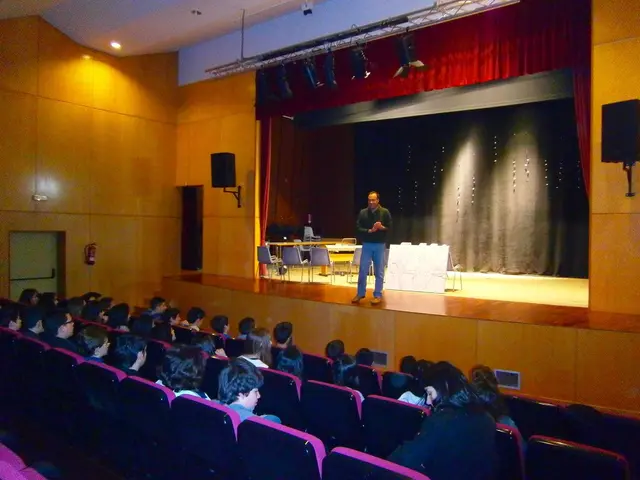"Daily Life in Ukraine Filled with Apprehension and Fear"
In the heart of Ukraine, the city of Kyiv continues to face a dire humanitarian crisis, with relentless Russian aerial attacks leaving essential services and civilian infrastructure in ruins. The United Nations (UN) reports a drastic increase in civilian casualties and a severe strain on humanitarian aid, as nearly 13 million people across Ukraine require assistance, but only about one-third of the required $2.6 billion funding has been secured [1].
Kyiv remains under constant threat, with missile and drone attacks regularly impacting living conditions and access to basic needs for its residents [1]. Despite these challenging circumstances, humanitarian aid efforts are ongoing, with organisations like United Help Ukraine launching the Aid Hub in Kyiv – a warehouse and logistics center that improves the direct receipt and distribution of aid to cities, villages, and frontline areas. This hub supports trauma victims, defenders, and broader humanitarian needs, emphasising transparency and efficiency in aid delivery within the city [2].
International cooperation also persists, with agencies such as the Italian Agency for Development Cooperation supporting vulnerable groups, including displaced persons and healthcare facilities, although some efforts focus on other regions like Transcarpathia [3]. However, funding gaps and the escalating displacement, with over 3.7 million internally displaced within Ukraine and nearly six million refugees abroad, exacerbate the crisis [1].
The continued aerial bombardments, including attacks on hospitals, schools, and energy infrastructure, have left no area completely safe and have worsened the living conditions for Kyiv residents and all Ukrainians [1][5]. Schools in Ukraine are often held in bunkers due to the ongoing war, and the UNHCR aims to reach 2.7 million people in Ukraine with its aid this year.
The war in Ukraine has far-reaching consequences for young people and the education sector. UNHCR aid worker Nina Winzen, who has been working in Kyiv for 19 months, reports that families live in daily fear for their lives. Her team provides assistance to displaced and evacuated people in Ukraine, providing life-saving immediate assistance to people living in frontline areas, recently evacuated or displaced, or whose homes have been destroyed by air strikes and shelling.
The UNHCR's work in Ukraine is one of its major operations, with a significant portion of its budget allocated towards cash assistance for people affected by war, particularly women and children. Lists of people in need are provided to the helpers by the ministries, with more and more people being forced to flee from the escalation of fighting in the front regions.
The UNHCR's work in Ukraine is complementary and aligned with the needs of the people, working closely with the government. Germany remains an important humanitarian partner and donor for Ukraine. However, dramatic cuts in humanitarian budgets are affecting refugees and displaced people worldwide, including in Ukraine.
Despite these challenges, the UNHCR, along with partners, is taking care of urgent repairs in Ukraine due to the massive destruction of homes. The cash assistance is used by the recipients for home repairs, medication, and heating. Psychological support, legal advice, and repairs of bombed-out houses are part of the UNHCR's work in Ukraine.
The UNHCR is active in over 130 countries and has been providing protection and assistance to people on the move for 75 years. As the crisis in Kyiv continues, the need for humanitarian aid remains urgent, and the UNHCR's efforts demonstrate a commitment to supporting the people of Ukraine in their time of need.
References:
[1] UN Office for the Coordination of Humanitarian Affairs (OCHA). (2025). Ukraine Humanitarian Needs Overview 2025. Retrieved from https://www.unocha.org/ukraine/humanitarian-action
[2] United Help Ukraine. (2025). Aid Hub in Kyiv. Retrieved from https://unitedhelpukraine.org/aidhub-kyiv/
[3] Italian Agency for Development Cooperation. (2025). Ukraine. Retrieved from https://www.aiditalia.org/en/interventions/europe/ukraine
[4] UNHCR. (2025). Ukraine: Emergency Appeal. Retrieved from https://donate.unhcr.org/ukraine-emergency-appeal
[5] Amnesty International. (2025). Ukraine: Escalating Attacks on Civilian Infrastructure. Retrieved from https://www.amnesty.org/en/latest/news/2025/07/ukraine-escalating-attacks-on-civilian-infrastructure/
- The community policy must address the dire humanitarian crisis in Kyiv, with focus on essential services and civilian infrastructure protection.
- The employment policy should prioritize humanitarian aid workers in the city, ensuring they are well-equipped to handle the growing needs.
- Education-and-self-development programs should be implemented for displaced children and youth, promoting personal growth and fostering resilience.
- Career-development opportunities should be provided to locals and refugees, enabling them to rebuild their lives and contribute to the recovery of the city.
- To prevent car-accidents and ensure safety, emergency response services and accident prevention education should be strengthened in Kyiv.
- Politics should play a supportive role in facilitating international cooperation and securing the needed funding for humanitarian aid efforts.
- Job-search assistance should be offered to internally displaced and refugee individuals seeking employment opportunities.
- General-news reporting should prioritize the humanitarian crisis in Ukraine, shedding light on the severity of the situation and the need for global action.
- Crime-and-justice coordination should be heightened in the city to prevent further victimization of residents and aid workers.
- Accidents, especially those related to fires, should be promptly addressed and evacuation procedures should be rehearsed regularly.
- Skills-training programs should be made available to aid workers and responders, improving their capability to manage the growing crisis.
- Sports can serve as a tool for boosting morale and providing a sense of normalcy amidst the war, with a focus on accessible and low-cost recreational activities.
- Football, soccer, basketball, baseball, hockey, golf, and other sports can be used to bring together communities and inspire hope.
- Champions-league, NFL, WNBA, NBA, MLB, NHL, racing, premier-league, American-football, and tennis events can act as fundraising opportunities for humanitarian aid efforts.
- Sports-betting could potentially be regulated in Ukraine, with a portion of the revenues allocated to support humanitarian aid programs.
- European-leagues and NCAA-basketball can lend support to the Ukraine relief efforts by organizing charity games or donating a portion of ticket sales.
- Tennis tournaments can feature exhibitions or charity events to raise funds for humanitarian aid in Ukraine.
- Sports-analysis programs and media outlets can highlight the impact of the crisis on Ukrainian athletes and promote awareness of the humanitarian crisis.
- Auto-racing events can partner with humanitarian organizations to host fundraising events and raise awareness for the crisis in Ukraine.
- Mixed-martial-arts organizations and fighters can contribute to the humanitarian aid efforts through various fundraising initiatives.
- Horse-racing competitions can donate a percentage of the prize money to support humanitarian aid programs in Ukraine.







